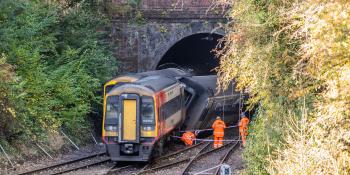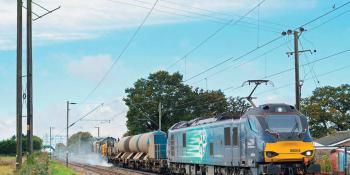
In a further update regarding the collision between two trains at Salisbury Tunnel Junction on the evening of 31 October, the Rail Accident Investigation Branch has outlined the scope of its forthcoming investigation.
At around 18.45 on 31 October, South Western Railway’s 17.20 Waterloo to Honiton (headcode 1L53) collided with the side of Great Western Railway’s 17.08 Portsmouth Harbour to Bristol Temple Meads (headcode 1F30) on the approach to Fisherton Tunnel, near Salisbury. The GWR service was using the junction to join the main line towards Salisbury as the SWR service was approaching from the Basingstoke direction. The impact of the collision caused the front two coaches of the SWR service and the rear two coaches of the GWR service to derail. Both trains continued some distance into Fisherton Tunnel before coming to a stop. Thirteen passengers and one member of railway staff required treatment in hospital, although fortunately there were no fatalities.

As outlined in a previous update, RAIB reports that signal SY31 was at danger, protecting the movement of the GWR service across the junction. The SWR service passed this signal while at danger by around 220 metres immediately prior to the collision occurring.
Preliminary analysis of the On Train Data Recorder (OTDR) on the SWR service shows the driver initially applied service braking to slow the train on the approach to the caution signal before signal SY31. Around 12 seconds after service braking started, the driver made an emergency brake demand. As the train approached signal SY31, and with the emergency brake still being demanded by the driver, a second emergency brake demand was made by the Train Protection and Warning System (TPWS). These emergency brake demands did not prevent the train from reaching the junction, where the collision occurred. RAIB says that OTDR analysis indicates wheel slide was present, both when the driver applied service braking and after emergency braking was demanded; it says the wheel slide was almost certainly a result of low adhesion between the train’s wheels and the rails.
As well as identifying the sequence of events leading to the accident, RAIB’s investigation will consider:
- the level of wheel/rail adhesion present on the approach to Salisbury Tunnel Junction;
- the status and performance of the braking, wheel slide protection and sanding systems on the SWR train;
- the behaviour of both trains during and following the collision;
- SWR’s policies relating to low wheel/rail adhesion;
- Network Rail's policies relating to low wheel/rail adhesion and how they managed the risk of low adhesion in this area;
- the processes used to assess and control the risk of overrun at signal SY31;
- any relevant underlying factors, including any actions taken in response to previous safety recommendations.
In a statement, SWR paid tribute to its driver, saying RAIB’s statement indicates he ‘reacted correctly to the signals by braking to slow the train down’.
The operator added: ‘He is a deeply respected colleague, who has over 50 years’ experience of driving on this route and an excellent professional track record. All our drivers are regularly assessed to the highest standards and he has fully satisfied all requirements.
‘Initial findings indicate that the driver acted in an impeccable way in a valiant attempt to keep his passengers safe, staying at the controls throughout. We thank him for his actions and we wish him a speedy recovery as he continues to be treated in hospital.’
Network Rail’s Safety and Engineering Director Martin Frobisher commented: ‘Initial findings suggest that low adhesion played a key part in causing the collision. It’s an issue that affects railways across the world and is something that we, and our train operator colleagues, work hard to combat – so that we can run trains safely and reliably throughout autumn, and why incidents such as the one in Salisbury at the weekend are incredibly rare.
‘We will continue to work closely with investigators to understand what happened and what more we can do to help prevent this happening again.’



